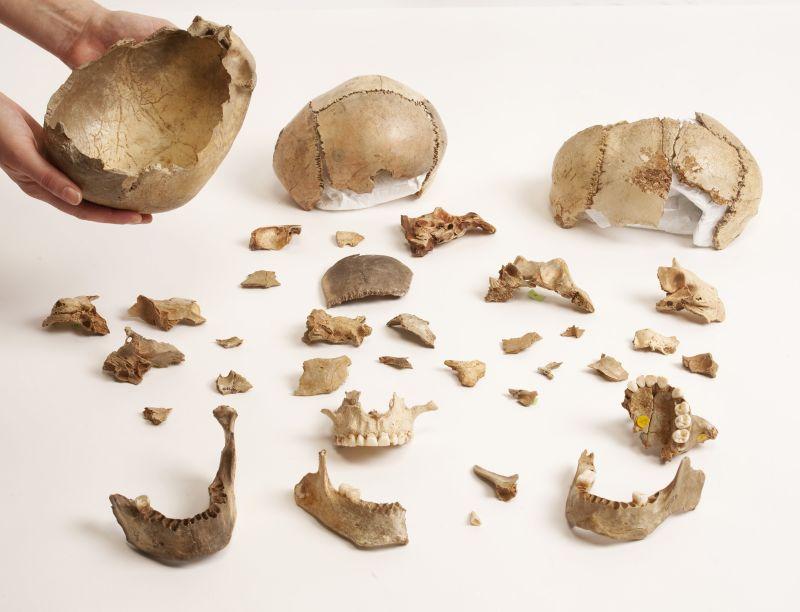Cannibalism was a common funeral ritual in Europe 15,000 years ago, study finds | CNN
By: Amarachi Orie (CNN)




Researchers had previously found skull cups at Gough's Cave site in England. Derek Adams/Trustees of the Natural History Museum
Cannibalism was a routine funerary practice in Europe about 15,000 years ago, with people eating their dead not out of necessity but rather as part of their culture, according to a new study.
While researchers previously found gnawed bones and human skulls that had been modified into cups at Gough's Cave in England, a study published in the journal Quaternary Science Reviews suggests this was not an isolated incident.
Their research focused on the Magdalenian period of the late Upper Paleolithic era. The Magdalenians lived some 11,000 to 17,000 years ago.
Experts at London's National History Museum reviewed literature to identify 59 Magdalenian sites that have human remains. Most were in France, with sites also in Germany, Spain, Russia, the United Kingdom, Belgium, Poland, the Czech Republic and Portugal.
They were able to interpret the funerary behaviors at 25 of the sites.
Fifteen showed evidence of human remains with chewing marks, skull bones with cut marks and bones purposefully broken in a pattern associated with the extraction of bone marrow for nutrients, indicating that cannibalism was practiced.
There was also evidence to suggest that in some cases human remains were mixed with those of animals.
The ritualistic manipulation of human remains and its frequent occurrence at sites across northern and western Europe suggested cannibalism was a burial practice - rather than to supplement diet - widespread in Magdalenian culture, researchers said.
"[It is] undeniable, that the frequency of cannibalistic cases among Magdalenian sites exceeds any incidence of this behaviour among earlier or later hominin groups, and suggests that mortuary cannibalism was a method Magdalenian people used to dispose of their deceased," the study said.

Human remains with chewing marks, skull bones with cutmarks and bones purposefully broken in a pattern associated with the extraction of bone marrow for nutrients were suggestive of cannibalism. Trustees of the Natural History Museum
"Instead of burying their dead, these people were eating them," study coauthor Silvia Bello, a paleoanthropologist and principal researcher at the National History Museum, said in a press release.
She added that cannibalism was "not simply practiced out of necessity."
"That in itself is interesting, because it is the oldest evidence of cannibalism as a funerary practice so far known," Bello added.
Funeral behavior associated with genetic ancestry
Researchers were also able to obtain genetic information from eight sites and combine it with the archaeological evidence to identify a relationship between funerary behavior and genetic ancestry.
They found that there were two distinct ancestral groups present in the region during that period - one of Magdalenian culture and another called the Epigravettian, a different European and geographically-distinct human culture.
Researchers found those belonging to the Magdalenian culture in northwestern Europe preferred to eat their dead, while humans from the Epigravettian culture preferred to bury their dead without cannibalism.
"There was a shift towards people burying their dead, a behaviour seen widely across south central Europe and attributed to a second distinct culture, known as the Epigravettian," the Natural History Museum said in the release.

Map of Magdalenian sites where cannibalism has been identified in northwestern Europe. Trustees of the Natural History Museum
The presence of regular burial during the Upper Magdalenian was down to the migration of individuals with Epigravettian-related ancestry into areas previously inhabited by people with Magdalenian-related ancestry who practiced funerary cannibalism, the study suggested.
"We believe that the change in funerary behaviour identified here is an example of demic diffusion where essentially one population comes in and replaces another population and that brings about a change in behaviour," said William Marsh, postdoctoral researcher at the museum, in the press release.
These are preliminary results and further analysis of the results at a larger scale is needed to fully examine the findings, the study authors said.
Thomas Booth, a senior laboratory research scientist at the Francis Crick Institute who was not involved in the study, told CNN Thursday: "We're missing the remains of most people who lived in Europe during the Palaeolithic and so it can always be tricky to be sure of what people did with their dead.
"However, this study provides pretty convincing evidence that ritual funerary cannibalism was practiced by people across Europe 20,000-14,000 years ago."
Trolling, taunting, spamming, and off topic comments may be removed at the discretion of group mods. NT members that vote up their own comments, repeat comments, or continue to disrupt the conversation risk having all of their comments deleted. Please remember to quote the person(s) to whom you are replying to preserve continuity of this seed. Any use of the phrase "Trump Derangement Syndrome" or the TDS acronym in a comment will be deleted. Any use of the term "Brandon", or any variation thereof, when referring to President Biden, will be deleted.




The practice of cannibalism has now been revived by the Republicans in Congress.
Rep. Matt Gaetz, a leading proponent of cannibalism, is running for re-election under the slogan "Eat Your Own!"
most of the funerals I've been to had a buffet afterwards, which I find to be a little disturbing somehow...
I thought only brown and black and red people ate each other.
Some diet conscious people prefer white meat.
... moms for liberty.
[✘]
[✘]
Smirk
Unfortunately, Trog Dahmer was a sensitive lonely boy with few friends...
This immediately reminds me of Stranger In A Strange Land...